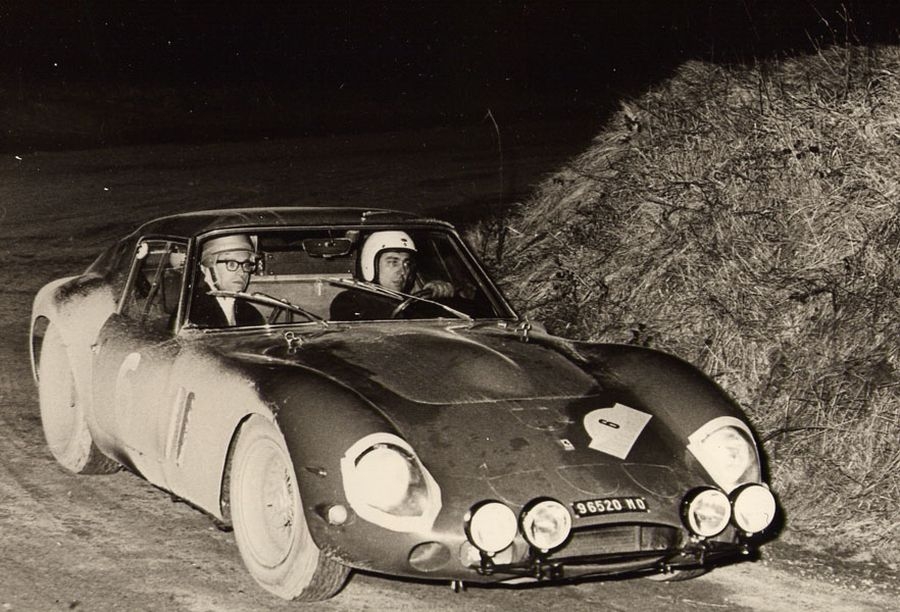Facts About Most Expensive Car Ever Sold at Auction In The World 2022?
 |
| What Is The Most Expensive Car In The World? |
There’s something to be said about the presence and power expensive cars demand. Chances are you've never heard of David MacNeil, but the WeatherTech founder and CEO have just joined one of the most exclusive clubs on Earth after paying a reported $70 million for a Tour de France-winning 1963 Ferrari 250 GTO.
What’s the most expensive car ever sold at auction?
The most expensive car ever sold at auction was a 1962 Ferrari 250 GTO, which went for $48.4 million (£36.5 million) in 2018 at a Sotheby’s auction during Monterey car week in California.
The model had seen some competition and Hillclimb racing and had been owned for the twenty years prior to its sale by a US Ferrari enthusiast, Dr. Gregory Whitten.
The second most expensive car sold at auction was another GTO that sold for $38.1 million (£28.8 million) in 2014. Another GTO sold in the most expensive private sale of all time for $70 million in 2018.
Just 36 GTOs were built between 1962 and 1964 and the model was designed for GT racing and to compete with the likes of the AC Cobra and Aston Martin DB4 GT.
Models were powered by the 3-liter version of the fabled Colombo V12 engine.
Although it looked great and featured a magnificent engine, it wasn’t especially innovative for its time and was a solid rather than dazzling performer on the track. By the 1970s, the GTO was an obsolete racing car with models being sold for four-figure sums.
But from the late seventies, as classic car values began to climb, so too went the values of GTOs. A production run of 36 is exclusive enough, but each model was very slightly different due to the fact that each was hand-built.
The combination of the looks, engine, hand-built body, and it is a racing car from what many consider Ferrari’s golden era, meant that apart from a few blips in the 1990s, GTO values have been on the up-and-up ever since, culminating in both the highest price ever paid in a private sale and the most expensive car sale ever made at auction.
Who bought the $70 million Ferrari?
 |
| Photo: wikipedia |
So, who would drop $70 million on a Ferrari 250 GTO? The car’s new owner is David MacNeil, a loyalist to the legendary car. He’s known for founding WeatherTech. MacNeil was already an avid Ferrari collector and aficionado.
And though he didn’t offer a direct comment about his purchase at the time, no one questioned why he had to have it. The 1963 Ferrari 250 GTO is the ultimate trophy for anyone who knows anything about vintage cars, which is why MacNeil felt compelled to spend $70 million to own it.
Vintage cars tend to go hand-in-hand with extreme prices. But when you have a classic supercar with unique design elements, revolutionary racing chops, and limited production, the allure only deepens. The 1963 Ferrari 250 GTO might be the collector’s ultimate prized possession.
And clearly, this legendary Ferrari doesn’t plan to give up its high-priced reputation anytime soon. At this rate, the car will likely grow exponentially in value. As long as these cars continue trading owners, Ferrari 250 GTO fans will continue watching in amazement.
About the Ferrari 250 GTOSince the 250 GTO is the Ferrari that has achieved the most acclaim, its history and details are worth investigating. Only 36 copies exist and all have colorful histories. 1960s racing was not about preservation: some cars lost their original engines and aluminum bodies long ago, which makes the few correct cars even more valuable. Despite many fakes, “all 36 examples of the genuine article are accounted for, none having ever been lost and all have documented lineage.” A couple of great books have been written on the subject and include the story of chassis 3589GT being rescued from a field. |
The autobiography of Ferrari 250 GTO 4153 GT
The car is chassis number 4153 GT and it won the Tour de France – an arduous 10-day race-cum-rally – in the hands of Lucien Bianchi and Georges Berger in 1964. That success typifies this car’s competition life, for it did virtually every form of motorsport, including endurance racing (it finished fourth in the Le Mans 24 Hours in 1963), hill-climbing, and rallying. All this is covered in fascinating detail, supported by a fine collection of period photographs, including color. Any Ferrari enthusiast will enjoy this addition to the ‘Great Cars’ series.
• This GTO’s racing career started with great promise at Le Mans in 1963, with fourth place for Pierre Dumay and Léon Dernier.
• Two busy seasons in 1964–65 brought 14 competition outings, with the win for Lucien Bianchi/Georges Berger in the 1964 Tour de France the highlight – and there was also a trip to Africa for the Angolan Grand Prix.
• The great Belgian teams, Ecurie Francorchamps and Equipe National Belge raced 4153 GT until the end of 1965.
• The car’s little-known competition career in Spain in the period 1966–69 is uncovered for the first time, with interview input from owner/driver Eugenio Baturone.
• Nearly 300-period photographs, many previously unpublished, supported by a portfolio of specially commissioned location photography.
What other models can claim the title of the most expensive car in the world?
The high price car may very well be the Bugatti La Voiture Noire, in part because there’s only one. Mimicking the Bugatti Chiron’s 16-cylinder engine, this beast of a hypercar will set you back an estimated $12.5 million, MotorTrend reports.
With a $9 million price tag, the Bugatti Centodieci comes in as the second-most expensive car to buy right now. And the Bugatti Divo averages about $5.7 million. Other pricey contenders include the Ferrari LaFerrari and Pagani Huayra, costing at least $1.4 million each.
Facts About The 1963 Ferrari 250 GTO
 |
| Photo: cartimes |
1. Race Car Heritage
Anyone who knows the 250 GTO knows it has a history as a racing car. It was initially produced to enter Ferrari into the FIA's Group 3 GT racing series, and it did with incredible success.
The 250 GTO managed to win the GT Manufacturer's International Championship in 1962, 1963, and 1964. Also, in the years 1963 and 1964 the 250 GTO won the Tour de France Automobile, kick-starting a run of nine years of Ferrari dominance.
2. The Engine
All of that racing wouldn't be possible without a pretty outstanding engine under the hood, and the 250 GTO is said to have one of the best engines ever put into any car to this day.
A true engineering masterpiece is what lies beneath the hood of the 250 GTO in the form of a 3.0-liter V12 outputting around 300 hp. This helped the Ferrari reach speeds exceeding 170 mph, making it astonishingly quick for a car made in the 1960s.
3. Extreme Rarity
Ferrari's are known for being somewhat collectible, after all, they are quite possibly the most famous and world-renowned manufacturer ever with a history of creating some of the greatest sports cars and supercars of all time.
None are as highly sought after as the 250 GTO. This is down to the sheer excellence of the car as well as its rarity, with only 39 cars being made. This makes it the ultimate collector's item for any motoring enthusiast.
4. Current Value
This level of rarity and near automotive perfection comes at a price. The 250 GTO is possibly the most valuable car on earth, and a number of these rare vehicles have been sold at auction for eye-watering prices.
There have been 250 GTO's sold at auction for prices in excess of $40M. A 1963 GTO also broke a world record for a private transaction for a car at $70M, making it by far the most valuable car in the world.
5. First Purchases And Original Price
Despite these ludicrous sums, the Ferrari hasn't always been that expensive, of course. Looking back at when the car was first introduced, it seems quite reasonably priced, all things considered.
In fact, back when the 250 GTO was introduced and available for purchase, the car had a price tag of $18,500. This is roughly $150,000 by today's standards. However, it wasn't just as simple as going down to your local Ferrari dealer and signing a few papers, you actually required approval from Enzo Ferrari himself before you were handed the keys.
6. The Design Process
The design of the GTO was a fairly complicated one with chief engineer Giotto Bizzarrini heading the 250 GTO operation, that was until he and a vast majority of Ferrari engineers were fired in 1962 after a dispute with Enzo Ferrari. Despite this, however, Bizzarrini is still often credited as the designer of the car.
Practically speaking, the design process wasn't too difficult, as the GTO used the engine and chassis components from previous competition cars, with its chassis being largely similar to the 250 GT SWB car. Improvements came in the structure, with weight reduction and a stiffer and lower chassis.
7. Variations In Models
Due to the hand-built nature of the vehicle, no two 250 GTO's were the same. The bodies were made from aluminum which was beaten and contained differences from the cosmetic to more mechanical ones.
Perhaps the best example of this is that of the initial 18 cars, which were supplied with the rear spoiler separately and later bolted to the body. One, in particular, had many changes and had a completely unique body design, looking more like the 330 LMB. The main differences included the rear wing and the size of the radiators.
8. Homologation Process
The process for getting the GTO into racing, to begin with, caused a little bit of trouble. This is because at the time in 1962, for a car to be entered into the Group 3 Grand Touring Car racing series, 100 production cars needed to be built according to FIA regulations.
As you may remember, only 39 250 GTO's were produced. For a while, a rumor persisted that Enzo Ferrari created an elaborate plan to shuffle the group of GTO's when the FIA inspectors came to evaluate, therefore giving the impression that many more cars existed. However, the truth is that the car passed due to the aforementioned 250 GT Berlinetta SWB as they shared the same basic DNA.
10. The Interior
Just like the exterior of the vehicle, the interior is also a sight to behold, with classic Ferrari craftsmanship on display in all its glory. However, there is very little on display given the intended purpose of the vehicle as a race car.
So much so, in fact, that at one point, Ferrari even considered removing the speedometer from the instrument cluster. The leather upholstery, carpets, and roof headlining were all swapped in favor of cloth seats and an exposed frame with stripped door panels. The 250 GTO is a true drivers' car, make no mistake.
11. Reliability
Rather strangely given that the car is indeed Italian and Italian cars typically have a reputation for breaking or having surprisingly poor build quality given the often high price tags, the 250 GTO is renowned still for its reliability.
The engine and chassis are nothing short of works of art, and the benefit of this is that the 250 GTO was incredibly reliable, especially for a race car. It's also helped by its incredibly rigid frame, making it very tough despite its racing purpose.
Why does the Ferrari 250 GTO cost so much?Only 39 of these supercars were produced, making them ultra-rare. And it’s even harder to find current owners who are willing to part with their unicorns. But other important factors contribute to the Ferrari 250 GTO price. For example, at the time, this car presented unique and revolutionary styling. And it was so different that the press called the 1961 prototype the “anteater” during first looks, Road & Track reported. Winning in a few road races also helped propel this car into the spotlight. You don’t see a 500,000% increase in value with a loser, Arnold Clark suggests. The Ferrari 250 GTO earned praise for winning the 1963 Tour de France event, with legendary driver Jean Guichet at the helm. And the third 250 GTO ever produced — the example sold in 2018 for $70 million — won the 1962 GT Championship and earned more than 15 other race wins from 1962 to 1965. Considering each car is hand-crafted, each Ferrari 250 GTO is uniquely distinct from the others, making it even more valuable. Attention to every detail makes a difference, especially when you’re buying a classic racecar. Additionally, securing Enzo Ferrari’s approval to buy one of these cars made it even more desirable. If there’s one thing that ultra-wealthy people can’t stand, it’s someone telling them they can’t own something. |
 Facts About World's Most Expensive House Built - Mukesh Ambani's Antilia Facts About World's Most Expensive House Built - Mukesh Ambani's Antilia What is the world’s most expensive house? Antilia – the place that Reliance Industries’ chairman, counted amongst the richest people in the world. |
 What Is The Most Expensive Man-Made Object In The World? What Is The Most Expensive Man-Made Object In The World? The most expensive man-made object is the International Space Station (ISS). What is it and how was it built? |
 What Is 'Everydays: The First 5000 Days' - World's Most Expensive NFT What Is 'Everydays: The First 5000 Days' - World's Most Expensive NFT What is the most expensive NFT in the world? The most expensive digital artwork sold at auction is EVERYDAYS: THE FIRST 5000 DAYS by digital ... |


























